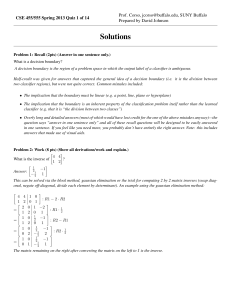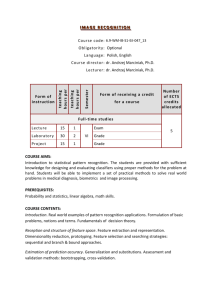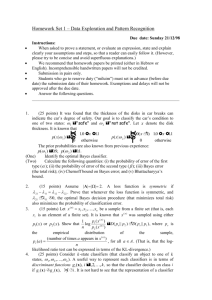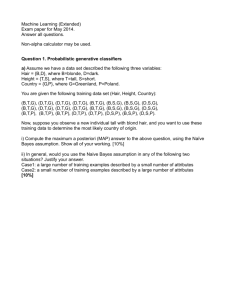ties iminating proper cteristic, discr ra
advertisement
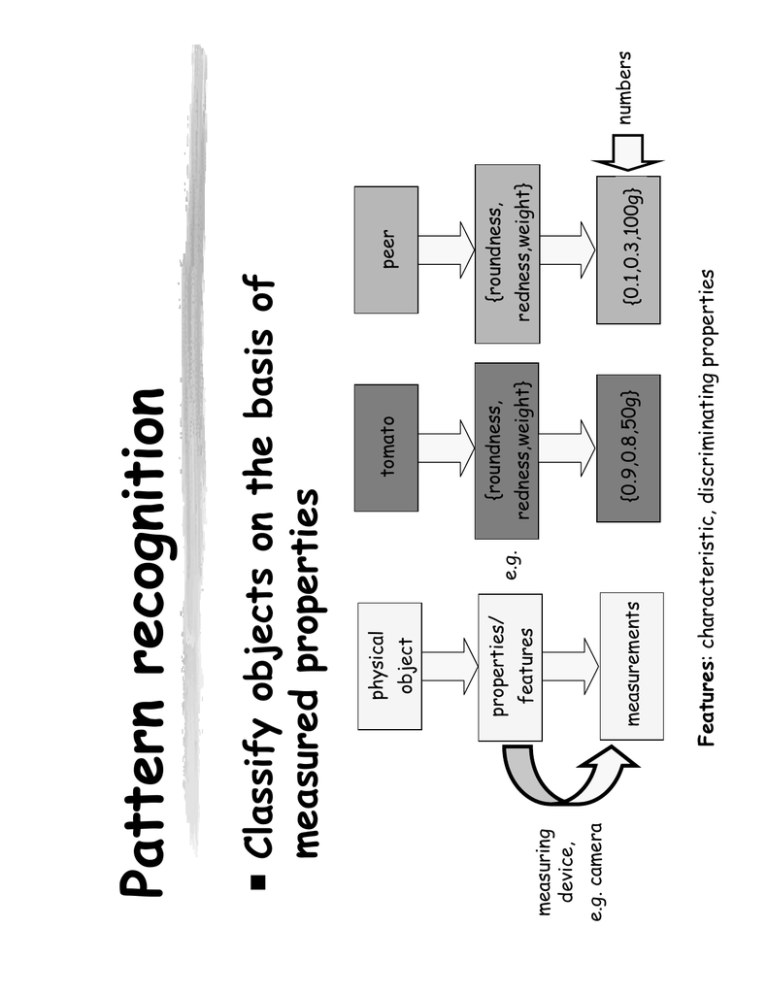
e.g. camera
measuring
device,
e.g.
redness,weight}
redness,weight}
{0.1,0.3,100g}
{roundness,
{roundness,
{0.9,0.8,50g}
peer
tomato
Features: characteristic, discriminating properties
measurements
features
properties/
object
physical
Classify objects on the basis of
measured properties
Pattern recognition
numbers
1
x 2 = (x2 , x22 )
(redness)
x2
{0.9,0.6}
{0.4,0.3}
{0.6,0.6}
B (pear)
x1 (roundness)
A (tomato)
1
x1 = (x1 , x21 )
{0.1,0.2}
{0.2,0.1}
Record images (sensor)
segment objects (segmentation)
measure features (analysis)
F: {redness, roundness}
Feature space
{0.8,0.9}
{0.7,0.9}
{0.7,0.8}
{0.3,0.4}
{0.4,0.2}
redness
B (pear)
measurement =
roundness
A (tomato)
inherent variation (e.g. biological)
+
measuring noise (e.g. digitization)
Similar objects (pears or tomatoes)
In feature space: cloud of points (intra-class variation)
Class
redness
?
A (tomato)
roundness
B (pear) ?
?
Compare objects on the basis of their
features
Pattern recognition
Define/find probability model
Classify on basis of probability for classes
By statistical modeling (Bayesian decision making)
Define/find decision boundaries D(x)
Classify on basis of (sign of) D(x)
By decision boundaries
Define/find prototypical examples of classes (Θ)
Classify on basis of similarity with prototypes
By prototypes
Pattern recognition
redness
B
B
roundness
B
A
A
Classify an unknown object to the label of
the nearest learning object
Compare to prototypes of class
Prototypes
redness
B
A
roundness
B
A
A
Decision
Boundary
Pattern recognition: Finding decision boundaries from
a set of example objects (learning)
decision boundaries
Classes: clouds in feature space separable by
Decision boundary
(redness)
x2
D2 ( x )
(3 errors)
x1 (roundness)
D1 ( x )
(redness)
x2
(6 errors)
D3 ( x )
x1 (roundness)
(2 errors)
Decision boundary → Minimizing error
Optimizing decision boundary
P (B | x )
redness
B
A
B
A
A
P (A | x )
If class A is more probably given
the measured values then decide
for class A
roundness
P (A | x ) > P (B | x ) x → A
else
x →B
Decision rule:
Bayesian decision making
Define/find probability model
Classify on basis of probability for classes
By statistical modeling (Bayesian decision making)
Define/find decision boundaries D(x)
Classify on basis of (sign of) D(x)
By decision boundaries
Define/find prototypical examples of classes (Θ)
Classify on basis of similarity with prototypes
By prototypes
Pattern recognition
x2
(redness)
fX ( x | B )
B (pear)
conditional probability densities
x1 (roundness)
fA ( x)
fX ( x | A )
A (tomato)
Feature vectors spread according to the class-
x = (x1 , x 2 ,..., x k )
Feature vector k-dimensional stochastic vector
Statistical analysis
If class A is more probably given
the measured values then decide
for class A
PAfA ( x ) > PBfB ( x ) x → A
else
x →B
Decision rule becomes (in known terms !):
fA ( x )PA
fA ( x )PA
=
P (A | x ) =
f (x )
fA ( x )PA + fB ( x )PB
Bayes’ Theorem:
P (A | x ) > P (B | x ) x → A
else
x →B
Desired decision rule:
Bayesian decision making
fB ( x )
(redness)
x2
B (pear)
D (x ) ≥ 0
D (x ) < 0
x1 (roundness)
Decision
boundary
fA ( x )
A (tomato)
x →A
x →B
Sign decision boundary determines classification
D ( x ) = fA ( x )PA − fB ( x )PB
Bayes classifier constructs decision boundary
Optimality Bayes classifier
pear
redness
D (x ) < 0
D (x ) = 0
D (x ) ≥ 0
D (x ) = 0
Decision boundary:
roundness
tomato
D (x ) ≥ 0 x → A
D (x ) < 0 x → B
Classification
Decision boundary: D(x)
ε = PB
( )≥ 0
( )<0
fB ( x )dx + PA ∫ fA ( x )dx
∫
D x
D x
Substitution of pdf’s:
ε = P (D ( x ) ≥ 0 | x ∈ B )PB + P (D ( x ) < 0 | x ∈ A )PA
Bayes rule
probability that object with label B
is classified as having label A
ε = P (D ( x ) ≥ 0, x ∈ B ) + P (D ( x ) < 0, x ∈ A )
Classification error:
Classification error
1-dimensional
problem
projection
f (x 1 )
fB (x1 )
B
fB ( x )
B (pear)
x1 (roundness)
A fA (x1 )
x1 (roundness)
A (tomato)
fA ( x )
Illustration (simplified)
fA ( x )PA
εB
A
D (x ) ≥ 0
fA ( x )
D (x ) = 0
= PA
B
D (x ) < 0
( )< 0
fA ( x )dx
∫
D x
fB ( x )
fB ( x )PB
ε A = P (B , x ∈ A ) = P (D (x ) < 0 | A)PA
Illustration Bayes error
ε = PA −
( )≥0
( )<0
(PAfA ( x ) − PBfB ( x ))dx
∫
D x
( )≥0
( )≥0
Integrate complete
interval: ∫ f (x )dx = 1
( )≥0
fB ( x )dx + PA ∫ fA ( x )dx + PA ∫ fA ( x )dx − PA ∫ fA ( x )dx
∫
D x
D x
D x
D x
( )<0
ε = PB
( )≥0
fB ( x )dx + PA ∫ fA ( x )dx
∫
D x
D x
Add and subtract
same term
(cont’d)
ε = PB
Rewrite
Classification error
( )≥0
(PAfA ( x ) − PBfB ( x ))dx
∫
D x
D ( x ) ≥ 0 if and only if
PAfA ( x ) − PBfB ( x ) ≥ 0
Thus, choose D(x) such that only
positive terms are integrating
Minimizing ε : maximizing 2nd term
ε = PA −
Minimize classification error ε
Bayes decision boundary
Optimal decision boundary (→ *)
D * ( x ) = PAfA ( x ) − PBfB ( x ) ≥ 0 x → A
<0 x →B
Decision boundary:
Optimal decision boundary
x →A
D (x ) ≥ 0
εB
D (x ) = 0
x →B
D (x ) < 0
εA
B
fB ( x )PB
Bayes error
Bayes error: Shifting D(x) causes increases ε
fA ( x )PA
A
ε = εA + εB = ε *
Bayes decision boundary
Bayes boundary
(cont’d)
D * (x ) = 0
D * (x ) < 0
D * (x ) = 0
D * ( x ) defines areas:
fA ( x )PA
A
B
fB ( x )PB
D * (x ) ≥ 0
D * (x ) = 0
ε*
*
D
( x ) not necessarily one point
Bayes boundary
(cont’d)
S * (x ) = 0
B
S * (x ) = 0
fB ( x )PB
Thus, D * ( x ) not necessarily a linear decision
boundary
fA ( x )PA
A
Two classes with the same mean:
classification still possible
Bayes boundary
PAfA ( x )
A
x →i
x
B PBfB ( x )
C
PC fC ( x )
x → A because PAfA ( x ) largest
i
with i = arg max { Pi fi ( x ) }
Classification according to
Multiple classes
A
B
A
B
D
A
B
C
Class clouds can have any shape → shape D(x) varies
Overlap exist → perfect (100% separation) D(x)
often does not exist
Multiple classes → D(x) describes multiple decisions
Bayes boundary revisted
non-parametric
→ known distribution model
→ no knowledge about
underlying distribution
→ estimate parameters from
→ tot restricting the pdf
learning set
→ restricting shape of pdf
parametric
D ( x ) = PAfA ( x ) − PBfB ( x ) ≥ 0 x → A
<0 x →B
Bayes classifier
Bayes decision making
Zero-crossings R(x) same as D(x)
R ( x ) = ln {PAfA ( x )} − ln {PBfB ( x )}
↓
D ( x ) = PAfA ( x )} − PBfB ( x )
Substituting fA (x),fB (x) in D(x)
Monotonic transformation
1
T
−1
fA ( x ) =
−
(
x
−
µ
)
Σ
exp{
A
A (x − µ A ) }
1/2
k /2
2
ΣA (2π )
1
Normal distribution fA (x),fB (x)
Parametric estimator
What shape?
Decision boundary found by setting R(x) = 0
R ( x ) = (x − µB )T ΣB−1 (x − µB ) − (x − µA )T ΣA−1 (x − µA ) +
PA
ΣA
2ln{ } + 2ln{ }
PB
ΣB
After substitution of fA (x),fB (x)
Normal-based classifier
x T ( ΣA−1 − ΣB−1 ) x
(cont’d)
Ellipse/circle
hyperbole
parabola
linear
ΣA = ΣB
Can take any quadratic shape
exact shape depends on the covariance ratios
Quadratic term:
Normal-based classifier
-5
0
5
10
15
-8
-10
-6
-4
-2
0
2
4
6
8
-10
-5
0
5
10
-10
-5
0
5
10
15
20
25
Linear decision boundary
-6
-10
-4
-2
0
2
4
6
5
10
15
-10
-5
0
5
10
-10
-5
0
5
10
15
20
(cont’d)
25
-15
-15
-10
-5
0
5
10
-10
-5
0
5
10
But, if data not normally distributed
then wrong decision boundaries
0
non-parametric
classifier
-5
Quadratic decision boundaries
Normal-based classifier
non-parametric
→ no knowledge about
→ known distribution model
underlying distribution
→ estimate parameters from
→ tot restricting the pdf
learning set
→ restricting shape of pdf
parametric
D ( x ) = PAfA ( x ) − PBfB ( x ) ≥ 0 x → A
<0 x →B
Bayes classifier
Bayes decision making
x1
A
NV
n
ˆ
f (x ) =
Number of bins grows exponentially
Need large learning set (large N)
Easy and effective, but
x2
Divide sample space in bins (volume V)
Estimate probability density by counting
samples of learning set in bin (n)
Histogram
∀
all learning objects
Kh ( x , y )
∑
N y
1
ˆ
f (x ) =
x =y
y
h
Kh ( x , y ) ≈ 0, d ( x , y ) zeer groot
Kh ( x , y ) = 1,
KERNEL
Weigh contribution of object y with
kernel K (x,y)
Object y close to x contributes more to f (x)
than an object z further away from x
Estimation f (x):
Parzen estimator
(cont’d)
x2 x3 x4
x5
x6x7 x8
x
∀
Kh ( x , y )
∑
N y
1
kernel width
fˆ( x ) =
Kernel width: influences the smoothness of f(x)
x1
Kh (x , y )
Estimation is sum of kernels placed at objects
Parzen estimator
A
x1
Can be wild; depends on what ?
x2
B
D (x ) = 0
∀
Kh ( x , y )
∑
N y
1
ˆ
f (x ) =
Shape decision boundary
PDF can have any
shape
Parzen estimator
D(x) of Parzen estimator
Extremes ?
Larger: increasing insensitivity for number of points
Smoothing parameter (h, kernel width)
less data: wilder shape
more points: can use smaller kernels
Number of data points:
Wildness:
D(x) of Parzen estimator (2)
x
(closer to object class B )
(closer to µA )
x
x →B
x →A
h → ∞ : Class of nearest mean
D(x) linear decision boundary
h ↓ 0 : Class of nearest object (learning set)
D(x) equal to Nearest Neighbor rule
Two extremes:
D(x) of Parzen estimator (3)
ε
nearest
neighbor
Varying h
lots of articles published on
how to select
h
optimal smoothing parameter
nearest mean
Euclidean distance classifier
Extremes Parzen D(x) (2)
x2
x1
j =1
j =1
else
x →B
PA ∏fA (x j ) > PB ∏fA (x j ) x → A
d
d
Naïve Bayes classifier
j =1
fA ( x ) = ∏fA (x j )
d
Assuming independent
features
Naïve Bayes Classifier
Define/find probability model
Classify on basis of probability for classes
By statistical modeling (Bayesian decision making)
Define/find decision boundaries D(x)
Classify on basis of (sign of) D(x)
By decision boundaries
Define/find prototypical examples of classes (Θ)
Classify on basis of similarity with prototypes
By prototypes
Pattern recognition
Holds also if
µA
A
R (x ) = 0
Σˆ = PA ΣˆA + PB ΣˆB
µB
B
When shape of R(x) linear
Equal covariance ( Σ = Σ)
A
B
Different means (µ ≠ µ )
A
B
Normal-based classifier
R ( x ) = Wx + w 0
Need only to estimate
k coefficients instead
of k x k matrix
2) When expecting that ΣA=ΣB then use this information
since due to noise estimates often show ΣA≠ΣB
Hence, enforcing ΣA=ΣB, makes the decision boundary
becomes more accurate
Rewrite as
R ( x ) = (µ A − µB )T Σˆ −1 x + Const .
1) less coefficients to estimate (less computational load)
Why?
Force that ΣA=ΣB during estimation of fA(x) and fB(x)
Classes linearly separable
Use of prior knowledge
→
D ( x ) = Wx with x0=1
i
i
2
i =1
E = ∑ (D ( x ) − L( x ) )
N
Minimize total square error:
i
x
Each object
has class label L( x i ) ∈ {-1,1}
Find W by minimizing classification error
i
i.e. D ( x i ) should equal L( x i ) for all x
D ( x ) = Wx + w 0
Assume linear decision boundary
Linear decision boundary
i
i
2
→ E = D −L
2
= (WX ) − L
W
T
= XX
(
Gives
)
T −1
XL
(
→ W = LT X T XX T
)
−1
T
(cont’d)
N
∂E
= ∑ 2(Wx i − L( x i ) )x i = X ( X TW T − L ) = 0
∂W
i =1
Optimize with respect to W
i =1
E = ∑ (Wx − L( x ) )
N
Substitute D ( x i )
Linear decision boundary
2
T
=Σ
LX
T
T
T
T
(XX )
T −1
x
T
(cont’d)
= (XL) = (NA µA − NB µB )
Resembling linear normal-based classifier
D ( x ) = Wx = (NA µA − NB µB )T Σ −1 x
Substitute covariance and mean
XX
T
Covariance and mean definitions
D ( x ) = Wx = L X
Decision function becomes
Linear decision boundary
d
y
f (y ,T ) = tanh( )
T
d
D ( x ) = f ∑w j x j
j =1
-1.5
-4
-1
-0.5
0
0.5
1
1.5
-3
-2
-1
.1
0
1
5
2
Apply non-linear activation (desirable properties)
j =1
D ( x ) = Wx = ∑w j x j
Linear decision function
Non-linear decision
3
25
4
xdi
…
x 2i
x1i
D (x i )
Perceptron: Non-linear decision function
Perceptron
xdi
…
x 2i
x 2i
x1i
Neural Net: Layered perceptrons
µA
σA
S (x ) = 0
σ B′
µB
σB
B
fB ( x )
( µA − µB )2
max{ 2
}
2
σA + σB
Fisher criterion
2) But, with respect to the spread of the classes
1) Means far apart : max{( µA − µB )2 }
fA ( x )
A
When are classes well separable ?
Fisher Linear Discriminant
between scatter
(Direction in which
the Fisher criterion
is maximal)
Fisher direction
Direction:
Sf ( x )
x2
B
µB
µA
within scatter
( µ A − µ B )2
σ A2 + σ B2
A
x1
S ′( x )
( µ A − µ B ) 2 ; between scatter
within scatter
Maximize between versus within scatter
Fisher’s criterion
Exactly same direction as the linear
Bayes classifier
difference with linear
Bayes classifier
Fisher: No assumption on normal densities (just class
separability)
Fisher: No error minimization but maximization
Fisher criterion
Note !
Df ( x ) = Wx + w 0
Df ( x ) = ( µA − µB )T Σ −1 x + Const .
Maximizing Fisher criterion:
Fisher’s decision boundary
Bayes classifier + assumption of normal-based
densities + equal covariance matrices
Fisher classifier
Perceptron
Derived from:
Linear classifier
Define/find probability model
Classify on basis of probability for classes
By statistical modeling (Bayesian decision making)
Define/find decision boundaries D(x)
Classify on basis of (sign of) D(x)
By decision boundaries
Define/find prototypical examples of classes (Θ)
Classify on basis of similarity with prototypes
By prototypes
Pattern recognition
redness
B
B
roundness
B
A
A
Classify an unknown object to the label of
the nearest learning object
Nearest neighbor classifier
(cont’d)
piecewise linear
contour
x2
Piecewise linear
Can have any shape
x1
:A
:B
Shape decision boundary NN classifier
NN classifier
(cont’d)
Solution ?
x2
λB
λA
λB
Outliers have a lot of influence!
NN classifier
x1
:A
:B
x2
λB
λA
x1
λA
:A
:B
Consider k nearest neighbors instead of one (1-NN)
Classify using majority rule of k neighboring classes
The larger k , the smaller the probability that
outliers influence the decision
k-NN classifier
K-NN classifier
ε k − NN = ε *
K=1: 1-NN becomes proportional classifier
k → ∞ ,N → ∞
k →0
N
lim
K→∞, N →∞: Choose class with highest density
Error approaches Bayes error
k →N
lim ε k − NN = min( PA , PB )
K=N: Choose class with highest probability
k-NN : Error analysis
Class assignment based on random experiment
Probabilities in the same ratio as the local densities
fA(x) and fB(x)
Proportional classifier
Assign to class A OR B (0/1)
But, fA(x) and fB(x) may both be greater than zero
Densities of A and B AFTER classification different
than in learning set
Bayes classifier
Proportional classifier
(cont’d)
qA ( x )
A
qB ( x )
As many objects assigned to
class B as class A
B
PAfA ( x )
P (A | x ) = qA ( x ) =
f (x )
prob. density function
after classification similar
as before classification
x → B with probability P (B | x ) = qB ( x )
x → A with probability P (A | x ) = qA ( x )
Not largest but random experiment!
Proportional classifier
Note! No relation with assignment
(random experiment): assignment
independent from true label
ε ( x ) = 2qA ( x )qB ( x )
Assignment by random experiment:
qA,qB
ε ( x ) = P ( x → A, x ∈ B )
+ P (x → B , x ∈ A)
ε ( x ) = P ( x → A )P (x ∈ B ) + P ( x → B )P (x ∈ A )
ε ( x ) = qA ( x )qB ( x )
+ qB ( x )qA ( x )
Classifier designed such that:
P (x ∈ A | x ) = P (x → A | x )
P (x ∈ A | x ) = qA
Definition
Error proportional classifier
ε =∫
*
S * (x )
ε*
S (x )
B
fB ( x )PB
f (x )
∫ min{PAfA (x ), PBfB (x )}f (x )dx
ε * = ∫ min{PAfA ( x ), PBfB ( x )}
Bayes error:
Integrating over lowest
probability density
fA ( x )PA
A
Express proportional classifier in Bayes
error
Bayes error revisited
qA ( x ) =
PAfA ( x )
f (x )
ε * = ∫ ε * ( x ) f ( x ) dx = E [ε * ( x )]
made for a given x
ε * ( x ) ; smallest error that is being
ε * = ∫ min{qA ( x ), qB ( x )} f ( x ) dx
*
min{PAfA ( x ), PBfB ( x )}
ε =∫
f ( x ) dx
f (x )
ε * = ∫ min{PAfA ( x ), PBfB ( x )}
Bayes error revisited (2)
1 − min{...}
*
2
ε prop = E [ε ( x )] = 2 E [ε * ( x )] − 2E [ε * ( x )2 ]
min{qA ( x ), qB ( x )}
Defined as:
Error proportional classifier
*
ε ( x ) = 2 ε ( x ) − 2{ε ( x )}
= 2 ε * ( x )(1 − ε * ( x ))
= 2 min{qA ( x ), qB ( x )} max{qA ( x ), qB ( x )}
ε ( x ) = 2 qA ( x )qB ( x )
Expected error in x
Error proportional classifier
*
ε prop < 2ε − 2ε
*2
2
*
*
2
Positive!
(subtract something from 2ε)*
*2
Worst case:
proportional classifier 2 times
as bad as Bayes classifier
(never smaller than ε*!!!!)
= 2ε * (1 − ε * )
ε prop = E [ε ( x )] < 2ε
*
*
E [y 2 ] > E [y ]2
E [ε (x ) ] > E [ε (x )] = ε
Bayes error: 2ε
var(y ) = E [y 2 ] − E [y ]2 > 0
ε prop = E [ε ( x )] = 2 E [ε * ( x )] − 2E [ε * ( x )2 ]
Error proportional classifier
B
PB fB ( x )
1 − NN
→ proportional classifier
n →∞
1-NN:Assignment to class of nearest object
In limiting case equal to proportional classifier
Probability of being assigned to a certain class depends
on the number of samples
PAfB ( x )
A
Assignment class A
1-NN : Error analysis
(cont’d)
Worst error
(opposite D(x))
On the average (2 samples are only one draw)
however good rules
ε * < ε NN < 1 − ε *
Each sample can lie exactly on class center ⇒ perfect
decision boundary
or it can lead to the worst decision boundary
If n < ∞, what can we say about εΝΝ
Nothing! Namely, if there are 2 samples:
n →∞
*
ε < ε NN < 2ε − 2ε
*
*2
1-NN : Error analysis
2ε *
1
: appears to be good rule of thumb
k ≈
N
: NN character of proportional classifier
*
( ε 1 − NN → 2ε )
k →1
k →N
k
: classification according ratio of classes
a priori probabilities: lim ε k − NN = min( PA , PB )
optimum
N
k →N
Choice of k
ε k −NN
min( PA , PB )
Classification according
a priori probabilities
k-NN : Error analysis
1
k
(cont’d)
Locally noisy → increasing k with one
can have large influence on ε
εk −NN
Practice
k-NN : Error analysis
(cont’d)
λB
x1
λA
:A
:B
Leads to Parzen density estimator (kernels)
x2
λB
Weight k nearest neighbors w.r.t. the distance
Alternative:
k-NN : Adaptations
(cont’d)
Editing:
decreasing ε
Condensing: decreasing computational load
Calculate distance to ALL learning samples
But, not necessary: Remember only those samples that
are in the vicinity of the decision boundary: Condensing
Computationally expensive (during classification)
Cause segments -> edit learning set
Outliers
Disadvantages:
k-NN : Adaptations
No guarantees; Only for large learning set
approaching Bayes decision boundary
Divide learning set into subsets
Select a learning and test set
Remove falsely classified samples (test set) from
learning set (don’t use them anymore)
Repeat; until all objects are classified correctly
Procedure
k-NN: Editing
Choose arbitrary learning sample
Classify sample according to the other learning
samples
If sample is falsely classified then add to new
learning set
Repeat until no errors appear
Procedure
k-NN: Condensing
original
after editing and condensing
Example Condensing
Optimal Bayes classifier
Parameterized densities: Normal-based classifier
Non-parameterized densities: Histogram, Parzen, Naïve
Bayes
By statistical modeling (Bayesian decision making)
Normal-based classifier (equal covariance)
Linear decision boundary, perceptron
Fisher linear classifier
By decision boundaries
K-nearest neighbor classifier
By prototypes
Summary

